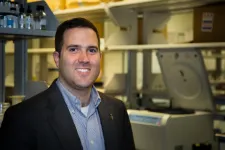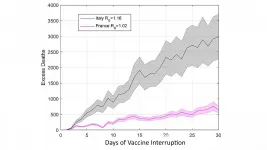Incentives could turn costs of biofuel mandates into environmental benefits
CABBI studies on the Renewable Fuels Standard indicate a need for more targeted policies that value the environmental benefits of perennial bioenergy crops over cheaper options - and provide incentives for farmers to grow them
2021-04-27
(Press-News.org) New studies from the Center for Advanced Bioenergy and Bioproducts Innovation (CABBI) shed more light on the economic and environmental costs of mandates in the Renewable Fuels Standard (RFS), a federal program to expand the nation's biofuels sector.
Researchers said the studies indicate the need to adopt more targeted policies that value the environmental and ecosystem benefits of perennial bioenergy crops over cheaper options -- and provide financial incentives for farmers to grow them.
The RFS was issued in 2005 and updated through the Energy Independence and Security Act of 2007 to enhance U.S. energy security, reduce greenhouse gas (GHG) emissions, and promote rural development. The 2007 standards mandated blending 36 billion gallons of first-generation biofuels (made from food crops like corn, such as ethanol) and second-generation biofuels (made from the biomass of miscanthus or other energy feedstocks) with fossil fuels by 2022, to replace petroleum-based heating oil and fuel. The corn ethanol mandate has been met, with 15 billion gallons produced annually, but production of cellulosic biofuels has been negligible. Targets beyond 2022 are yet to be determined.
The biofuel mandates impact the environment in multiple ways -- affecting land use, GHG emissions, nitrogen (N) application, and leakage of harmful nitrogen compounds into the soil, air, and water. Those impacts vary by feedstock, as do the economic costs and benefits for consumers buying food and fuel and for producers, depending on cultivation costs and the competition for cropland for alternative uses.
The first study calculated the net economic and environmental costs of the RFS mandates and found that maintaining the corn ethanol mandate would lead to a cumulative net cost to society of nearly $200 billion from 2016 to 2030 compared to having no RFS. The social cost of nitrogen damage from corn ethanol production substantially offsets the social benefits from GHG savings.
On the other hand, implementation of the additional cellulosic mandate could provide substantial economic and environmental benefits with technological innovations that lower the costs of converting biomass to cellulosic ethanol and policies that place a high monetized value for GHG mitigation benefits. That study, published in Environmental Research Letters, was led by CABBI Sustainability Theme Leader Madhu Khanna and Ph.D. student Luoye Chen from the University of Illinois Urbana-Champaign.
The second study examined how full implementation of the RFS mandates will affect water quality in the Mississippi/Atchafalaya River Basin (MARB) and Gulf of Mexico, which are plagued by nitrogen runoff from corn and soybean fields. Rising N levels have depleted oxygen and created a hypoxic dead zone in the gulf. Specifically, this study looked at whether diversifying cropland with perennial energy crops -- such as CABBI grows -- could reduce N loss associated with corn production and thus improve water quality while meeting RFS goals.
It found that the most economical place to grow perennial bioenergy crops, which typically require less nitrogen fertilizer and lower N runoff, was on idle cropland. This limited their potential to reduce N runoff, which would be highest if they replaced N-intensive row crops on cropland. The N reduction benefits of bioenergy crops would also be more than offset by the increase in runoff generated by the harvesting of low-cost crop residues such as corn stover -- leaves and stalks of corn left after the grain is harvested -- for cellulosic biomass. The findings suggest that targeted incentives for reducing N loss are needed to persuade growers to replace N-intensive row crops as well as biomass from corn stover with bioenergy crops. Published in Environmental Science and Technology, the study was led by Associate Professor of Agronomy Andy VanLoocke and Ph.D. student Kelsie Ferin of Iowa State University.
Together, the studies showed that maintaining the corn ethanol mandate pushes more land into corn production, which increases the market price of other agricultural commodities. While producers might benefit from higher market prices, consumers who buy fuel or agricultural products pay the cost. And although the corn ethanol mandate can help mitigate GHG by displacing fossil fuels with biofuels, it increases nitrogen leaching because of increased fertilizer use with expanded corn production. That worsens water quality in the MARB and Gulf of Mexico and leads to a huge environmental and social cost.
In contrast, the cellulosic ethanol mandate could provide an overall benefit with the right policies. Supporting research and development to lower the cost of converting biomass to cellulosic ethanol would substantially reduce production costs and increase social benefits, and a high monetized value for GHG mitigation could offset all other costs.
These findings should lead policymakers to question the effectiveness of technology mandates like the RFS that treat all cellulosic feedstocks as identical. It incentivizes cheaper options like corn stover and limits incentives to grow high-yielding perennial energy crops that have lower carbon intensity and N-leakage but are more costly under current technology.
CABBI researchers hope performance-based policies -- including the low carbon fuel standard, carbon and nitrogen leakage taxes, or limits on crop-residue harvest and N application -- can be implemented to supplement the RFS mandates after 2022.
The complexity of biofuel policies requires expertise from both agronomists and economists, as in these studies. Both research teams developed integrated economic and biophysical models incorporating a broad range of factors into their analyses.
"CABBI provides a great opportunity for this kind of research, inspiring collaborations from different disciplines," Khanna said.
INFORMATION:
Coauthors on the first study included Ferin, VanLoocke, and Jia Zhong, a Ph.D. candidate with the Khanna lab, all from CABBI; and former CABBI Senior Research Scientist Deepayan Debnath. Coauthors on the second study included Chen, Khanna, Zhong, former CABBI Postdoctoral Research Associate Sarah Acquah (also with the Khanna lab), and Emily Heaton, Professor of Crop Sciences at Illinois and CABBI Feedstock Production Theme Leader.
[Attachments] See images for this press release:

ELSE PRESS RELEASES FROM THIS DATE:
2021-04-27
MEMPHIS, Tenn. - For the first time in published literature, Le Bonheur Children's Hospital and University of Tennessee Health Science Center (UTHSC) researchers showed that a variety of white blood cells known as eosinophils modify the respiratory barrier during influenza A (IAV) infection, according to a recent paper in the journal Cells. This research could have implications in understanding SARS-CoV-2 (COVID-19) infection in asthmatic patients.
The Le Bonheur/UTHSC study found that eosinophils immunomodulate airway epithelial cells during IAV infection, helping to neutralize the virus and ...
2021-04-27
The legend of the "kraken" has captivated humans for millennia. Stories of deep-sea squid dragging sailors and even entire ships to their doom can be found in everything from ancient Greek mythology to modern-day movie blockbusters. It is therefore ironic that the species that inspired these stories, the giant squid Architeuthis dux, is camera-shy. In fact, filming this species in the wild has proven an insurmountable challenge for countless scientists, explorers, and filmmakers. To date, only one scientist, Dr. Edith Widder of the Ocean Research & Conservation Association, has repeatedly caught a live giant squid on camera. In a new study, Dr. Widder and her colleagues have finally revealed the secrets behind their success. This study, which is free to access, also ...
2021-04-27
An Academic Analytics Research Center (AARC) study published in the journal Scientometrics found that senior faculty (scholars who earned their terminal degree 30 or more years ago) research publication activity exceeded expectations based on age cohort population for book chapters and book publications, and senior scholars largely kept pace in terms of journal article publications. "Across all disciplines, senior faculty may be uniquely positioned to invest their time in a longer-term publication effort, shifting their research focus to the review and synthesis of ideas through the publication of books and chapters," said AARC Senior Researcher and Co-Author of the study, Bill Savage, Ph.D.
The study explored the publishing activity of 167,299 unique faculty members at American ...
2021-04-27
Aromatics are major building blocks of polymers, or plastics, that turn up as everything from PET bottles for water to breathable, wrinkle-resistant polyester clothing. These petrochemicals comprise a specialized, value-added sector of the energy industry. The process for refining crude oil into useful aromatic streams for derivative use often involves the usage of a catalyst to facilitate chemical reactions. Among the various types of catalysts, many are zeolites - porous aluminosilicates - such as ZSM-5, a unique synthetic zeolite prolifically used in the upgrading of chemicals in alkylation and isomerization. Petrochemicals producers are constantly looking to minimize overhead costs to weather the volatility in commodity markets and provide a competitive end product ...
2021-04-27
NEWPORT NEWS - Nuclear physicists have made a new, highly accurate measurement of the thickness of the neutron "skin" that encompasses the lead nucleus in experiments conducted at the U.S. Department of Energy's Thomas Jefferson National Accelerator Facility and just published in Physical Review Letters. The result, which revealed a neutron skin thickness of .28 millionths of a nanometer, has important implications for the structure and size of neutron stars.
The protons and neutrons that form the nucleus at the heart of every atom in the universe help determine each atom's identity and properties. Nuclear physicists are studying different nuclei to learn more about how these protons and neutrons act inside the nucleus. The Lead Radius Experiment collaboration, called PREx (after ...
2021-04-27
WASHINGTON, April 27, 2021 -- A wide variety of portable and wearable electronics have become a large part of our daily lives, so a group of Stanford University researchers wondered if these could be powered by harvesting electricity from the waste heat that exists all around us.
Further inspiration came from a desire to ultimately fabricate energy converting devices from the same materials as the active devices themselves, so they can blend in as an integral part of the total system. Today, many biomedical nanodevices' power supplies come from several types of batteries that must be separated from the active portion of the systems, which is not ...
2021-04-27
WASHINGTON, April 27, 2021 -- The AstraZeneca COVID-19 vaccine is suspected of being linked to a small number of deep vein thrombosis (DVT) cases, which recently emerged within Europe as millions of people received vaccinations. This led several countries to suspend AstraZeneca injections and investigate the causal links to DVT.
Researchers within Europe teamed up to explore a hypothesis that pausing AstraZeneca vaccinations, even for a short duration, could cause additional deaths from the faster spread of COVID-19 within a population of susceptible ...
2021-04-27
What The Study Did: Researchers examined whether younger age at onset of type 2 diabetes was associated with an increased risk of subsequent dementia.
Authors: Archana Singh-Manoux, Ph.D., of the Université de Paris, is the corresponding author.
To access the embargoed study: Visit our For The Media website at this link https://media.jamanetwork.com/
(doi:10.1001/jama.2021.4001)
Editor's Note: The article includes conflict of interest and funding/support disclosures. Please see the article for additional information, including other authors, author contributions and affiliations, ...
2021-04-27
What The Study Did: Survey data were used to estimate the rate of human papillomavirus (HPV) vaccination among young adults ages 18 to 21 in the United States.
Authors: Michelle M. Chen, M.D., M.H.S., of the University of Michigan in Ann Arbor, is the corresponding author.
To access the embargoed study: Visit our For The Media website at this link https://media.jamanetwork.com/
(doi:10.1001/jama.2021.0725)
Editor's Note: The article includes conflict of interest and funding/support disclosures. Please see the article for additional information, including other authors, author contributions and affiliations, conflict of interest and financial disclosures, and funding and support.
# # #
Media advisory: The full study is linked ...
2021-04-27
What The Study Did: Researchers compared reasons for hospitalizations in children's hospitals in the United States before and during the COVID-19 pandemic.
Authors: Jay G. Berry, M.D., M.P.H., of Harvard Medical School in Boston, is the corresponding author.
To access the embargoed study: Visit our For The Media website at this link https://media.jamanetwork.com/
(doi:10.1001/jama.2021.4382)
Editor's Note: The article includes conflict of interest and funding/support disclosures. Please see the article for additional information, including other authors, author contributions and affiliations, conflict of interest and financial disclosures, and funding and support.
# ...
LAST 30 PRESS RELEASES:
[Press-News.org] Incentives could turn costs of biofuel mandates into environmental benefits
CABBI studies on the Renewable Fuels Standard indicate a need for more targeted policies that value the environmental benefits of perennial bioenergy crops over cheaper options - and provide incentives for farmers to grow them




